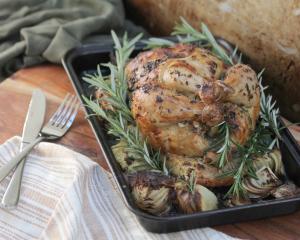
In 2011, Julie Lin made a note to self on Facebook: "New mission in life," she wrote in a status update: "be Nigella Lawson." At the time, she was working in retail in Glasgow and teaching piano and violin while channelling most of her creative energies into cooking dinner parties for friends. Flash forward 13 years and while Lin may not have fulfilled her mission exactly as stated, she’s been making all the right moves in that direction.
First she went on MasterChef in 2014 and made it to the quarter finals. Then she quit her job and became a chef, before setting up her own street-food stall in Glasgow. She graduated to a "proper"restaurant on the city’s south side in 2017, then a larger one called GaGa which is still going strong today.
Now she’s written a cookbook, which unites the two parts of her heritage — Malaysian and Scottish — in unexpected and delicious ways.
"My mum’s from Malaysia, and I go there every year," she says. Her father is Scottish and she grew up in Glasgow "with an abundance of amazing Scottish produce. So it feels like I’m from both places."
Chinese sausage bucatini carbonara
Carbonara will forever be one of my favourite dishes. The Chinese sausage (lap cheong) I use is an ambient food, so I always tend to have it in the cupboard. It’s truly one of the finest ingredients — its smoky sweetness makes it taste like maple-cured bacon and it works perfectly with the rich egg yolks. Allowing the fat to render a little releases the oils into the dish and creates the most moreish flavour.
Serves 2
200g dried bucatini (or another long pasta)
40g Chinese sausage (lap cheong), thinly sliced at an angle
1 Tbsp olive oil
4 cloves garlic, peeled and finely chopped
3 egg yolks
50g parmesan, grated, plus extra to serve
1 tsp light soy sauce
½ tsp kecap manis (sweet soy sauce)
salt and black pepper
Method
Bring a large saucepan of well-salted water to the boil. Add the bucatini to the pan and cook for 8 minutes (or according to the packet instructions).
Meanwhile, in a dry frying pan, gently fry the sausage over a low heat until the oils are released, allowing it to get a bit crisp. Remove the sausage from the pan and set aside. Add the olive oil to the pan and fry the chopped garlic until fragrant but not browned.
Using a fork, whisk together the egg yolks, grated parmesan, soy sauce, kecap manis and a pinch of salt in a bowl.
Once cooked, drain the bucatini, reserving some of the pasta cooking water. Add the sausage back into the pan along with the drained bucatini and toss in the garlic oil. Slowly add a little of the pasta cooking water to the egg yolk mixture until glossy and combined. Pour this over the hot pasta and sausage and mix together. Serve immediately with black pepper and the extra parmesan grated on top.

Chinese-style spicy garlic celery
Celery divides people. I think that’s because most of us are introduced to it in the form of batons dipped into hummus. But I adore celery in its cooked form, especially with soy and garlic. This is a version of a common wok-fried celery dish we eat at large banquets in Malaysia.
Serves 1
2 Tbsp Shaoxing rice wine
3 Tbsp light soy sauce
1 tsp white sugar
2 Tbsp vegetable oil
1 bunch, celery sliced on an angle
5 cloves garlic, peeled and finely diced
1 tsp cornflour, plus
3 Tbsp water to make a paste
1 tsp Malaysian crispy prawn chilli
or crispy chilli oil
salt and ground white pepper
Method
In a small bowl, mix together the Shaoxing rice wine, soy sauce and sugar.
Heat the vegetable oil in a wok over a high heat.
Add the celery to the hot oil and stir-fry for 1 minute, or until a little translucent. Next, add the garlic and stir-fry for 2-3 minutes, or until fragrant.
Add the rice wine, soy and sugar mixture, then add the cornflour paste and stir-fry until everything thickens slightly. Allow all of the flavours to come together, then taste and adjust the seasoning with salt and white pepper.
Finally, add the crispy prawn chilli or crispy chilli oil and make a few last tosses.
Serve immediately while piping hot.

Nasi goreng with smoked mackerel
Nasi goreng is probably one of the most recognisable dishes in Indonesian and Malaysian cuisines. Nasi means rice and goreng means fried, so it translates simply as fried rice. Full of flavour, this dish can be adapted to use up any ingredients you have in the fridge. I adore adding mackerel to this; the smokiness makes it extra punchy. It’s important to cook out the paste (rempah) here so that all of the roundness of the flavours can coat the rice. All of the day-old rice grains should absorb maximum flavour. Remember, nasi goreng is a simple dish to cook, but it’s all about making sure it’s not still wet at the end of the frying process.
Serves 2
vegetable oil for frying
2 spring onions, chopped into 4cm chunks
150g fine green beans, trimmed
50g smoked mackerel, flaked
300g cooked and cooled jasmine rice (preferably a day old)
1 ½ tsp kecap manis (sweet soy sauce)
1 ½ Tbsp fish sauce, or to taste
4 eggs
150g beansprouts
For the rempah
1 long shallot, peeled and roughly chopped
5 cloves garlic, peeled and roughly chopped
2 fresh long red chillies, deseeded and roughly chopped
4 dried red chillies, soaked in warm water for
20 minutes, drained, deseeded
2 Tbsp dried anchovies (ikan billis)
Seasoning station (optional)
sambal belacan, chilli crisp oil, fish sauce, light soy sauce, lime juice, salt
Method
First, make the rempah. Place all the ingredients in a food processor or blender and blitz to a paste. Heat plenty of oil in a wok over a medium-high heat. (You need lots of oil to make the paste oily enough that it coats the rice.) Once the wok is hot, add the rempah, spring onion chunks, trimmed green beans and flaked mackerel. Fry everything for 1-2 minutes, stirring continuously so that the paste doesn’t catch and burn. Turn the heat down, then add the cooled rice to the wok with a few tablespoons of water. Add the kecap manis and fish sauce, stirring furiously until everything is mixed together.
Create a well in the centre of the rice. Keeping the heat on medium-low, crack two of the eggs into the centre of the well and allow them to scramble. Once fully cooked through, mix the scrambled egg through the rice with the beansprouts.
Heat enough oil to cover the base in a separate pan over a very high heat. Once the oil is very hot, crack the remaining two eggs into the pan. Fry until the skirts of the eggs are golden and crispy.
When ready to serve, spoon the rice into two bowls and top with the crispy fried eggs. Add whichever of the ingredients you fancy from the seasoning station. — The Observer












